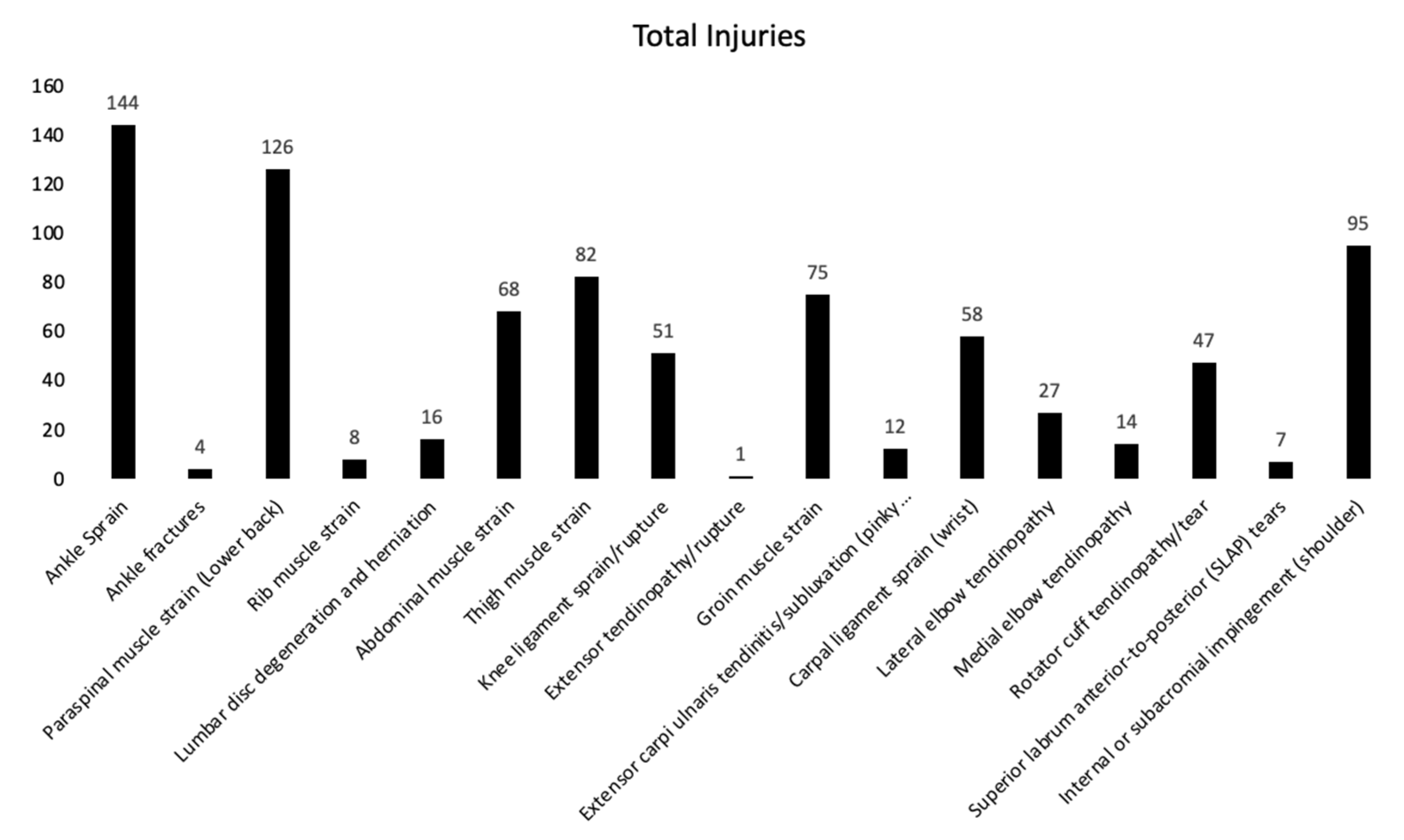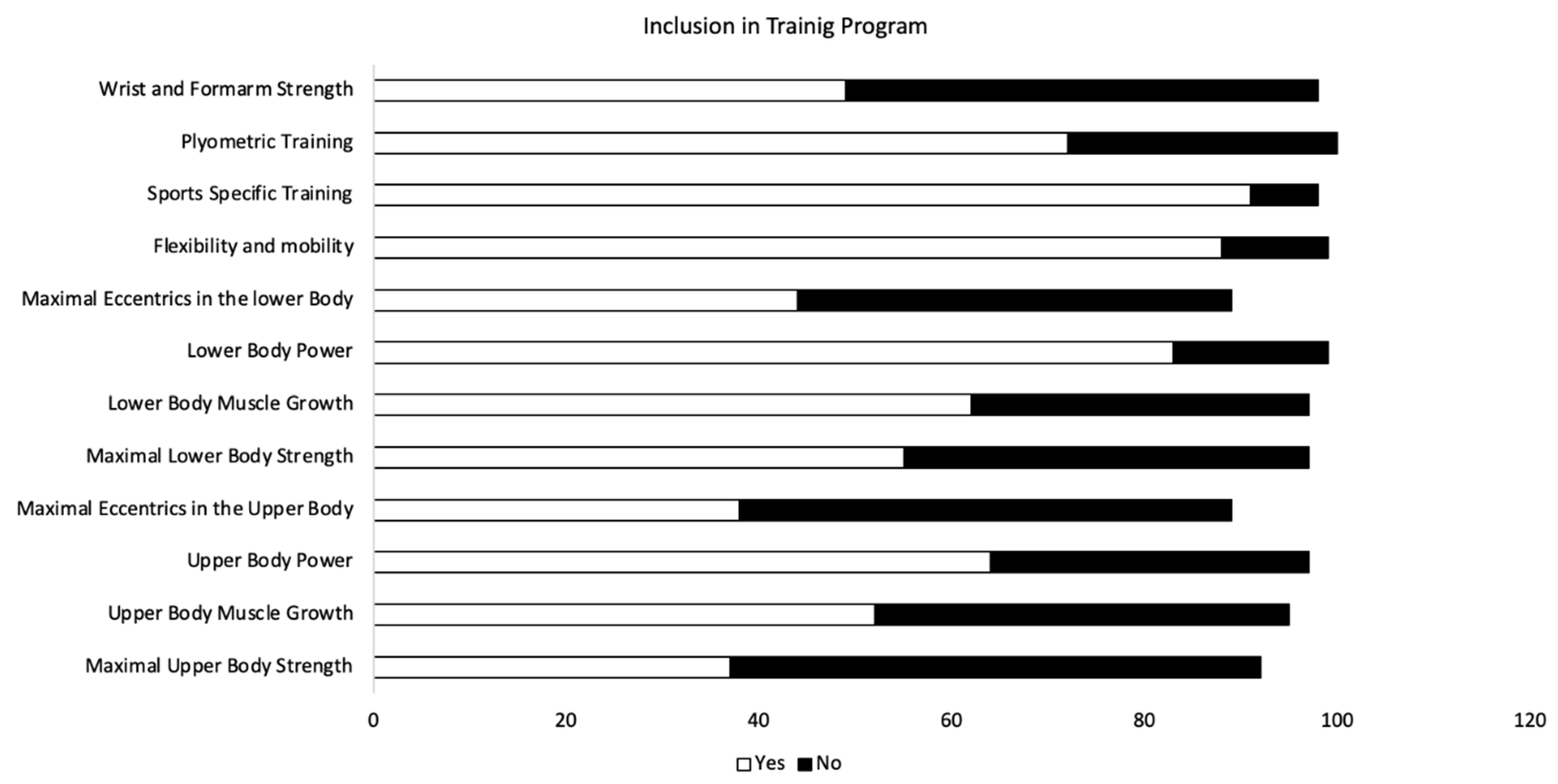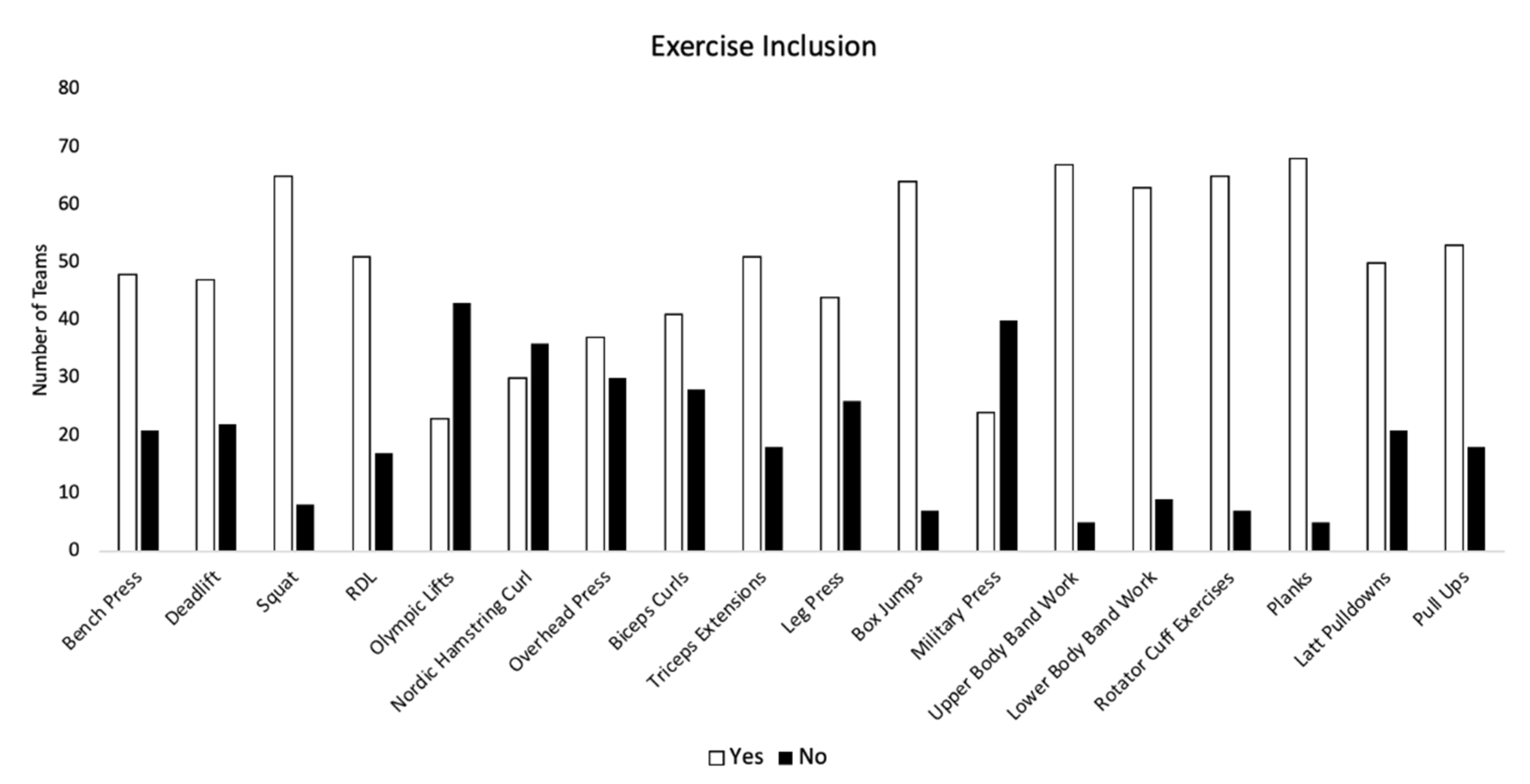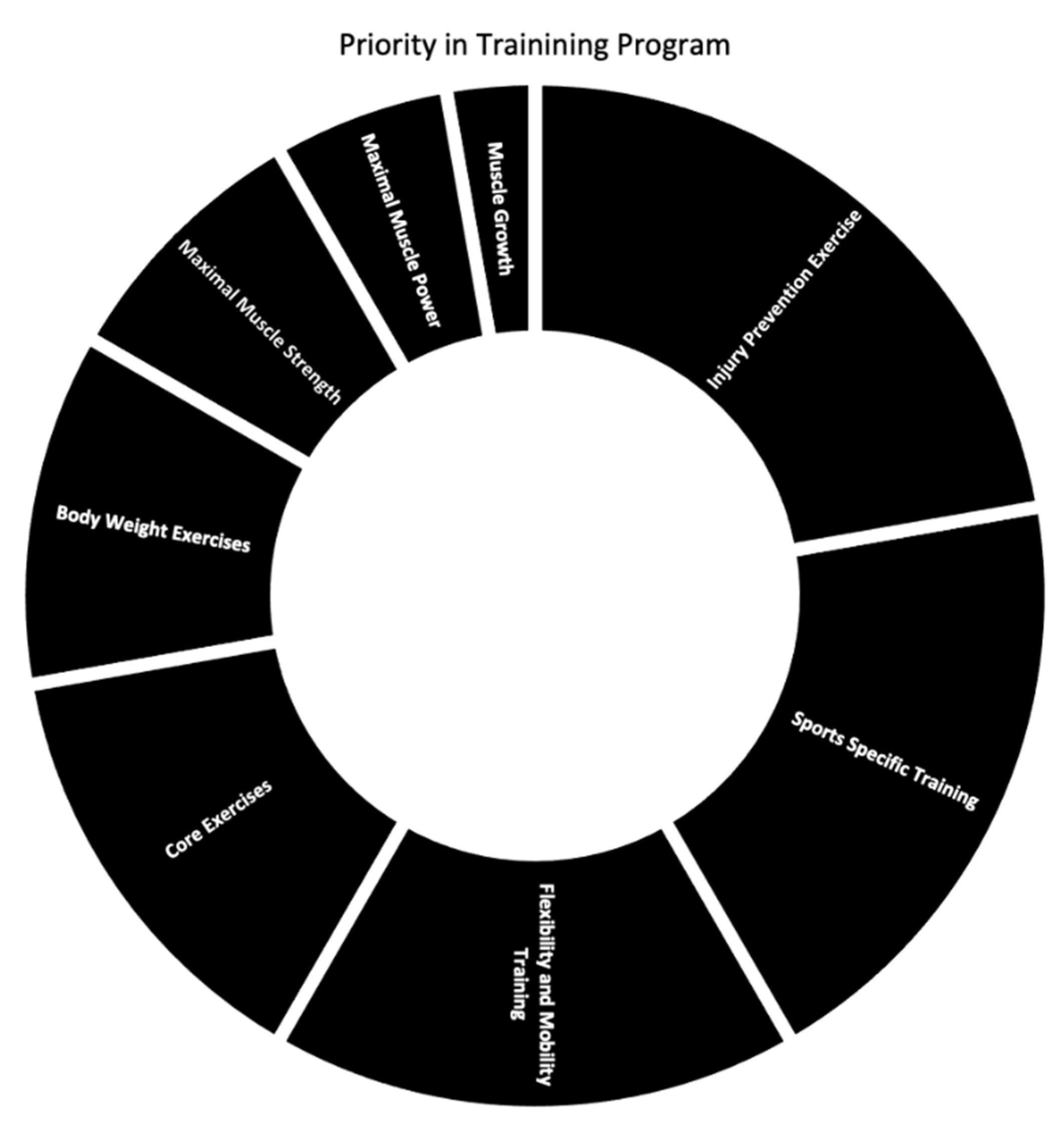Injuries and Strength Training Practices in Collegiate Tennis
Abstract
1. Introduction
2. Materials and Methods
2.1. Participants
2.2. Design and Procedures
2.3. Survey
2.4. Injury Identification
2.5. Strength and Conditioning Practices
2.6. Analysis
3. Results
4. Discussion
4.1. Injuries
4.2. Injures and Strength and Conditioning Practices
4.3. Strength and Conditioning Practices
5. Conclusions
Author Contributions
Funding
Institutional Review Board Statement
Informed Consent Statement
Data Availability Statement
Conflicts of Interest
References
- Chandler, T.J. Exercise training for tennis. Clin. Sport. Med. 1995, 14, 33–46. [Google Scholar] [CrossRef]
- Kibler, W.B.; Safran, M. Tennis injuries. Med. Sport. Sci. 2005, 48, 120–137. [Google Scholar] [PubMed]
- Safran, M.; Hutchinson, M.; Moss, R.; Albrandt, J. A comparison of injuries in elite boys and girls tennis players. In Proceedings of the 9th Annual meeting of the Society for Tennis Medicine and Science, Indian Wells, CA, USA, 23–24 March 1999. [Google Scholar]
- Lynall, R.C.; Kerr, Z.Y.; Djoko, A.; Pluim, B.M.; Hainline, B.; Dompier, T.P. Epidemiology of National Collegiate Athletic Association men’s and women’s tennis injuries, 2009/2010–2014/2015. Br. J. Sport. Med. 2016, 50, 1211–1216. [Google Scholar] [CrossRef] [PubMed]
- Ojala, T.; Häkkinen, K. Effects of the tennis tournament on players’ physical performance, hormonal responses, muscle damage and recovery. J. Sport. Sci. Med. 2013, 12, 240. [Google Scholar]
- Gescheit, D.T.; Cormack, S.J.; Reid, M.; Duffield, R. Consecutive days of prolonged tennis match play: Performance, physical, and perceptual responses in trained players. Int. J. Sport. Physiol. Perform. 2015, 10, 913–920. [Google Scholar] [CrossRef]
- NCAA. 2021–2022 NCAA Dividion I Manual. Available online: https://web3.ncaa.org/lsdbi/reports/getReport/90008 (accessed on 17 August 2021).
- Askling, C.; Karlsson, J.; Thorstensson, A. Hamstring injury occurrence in elite soccer players after preseason strength training with eccentric overload. Scand. J. Med. Sci. Sport. 2003, 13, 244–250. [Google Scholar] [CrossRef]
- Petersen, J.; Thorborg, K.; Nielsen, M.B.; Budtz-Jørgensen, E.; Hölmich, P. Preventive effect of eccentric training on acute hamstring injuries in men’s soccer: A cluster-randomized controlled trial. Am. J. Sport. Med. 2011, 39, 2296–2303. [Google Scholar] [CrossRef]
- Kraemer, W.J.; Ratamess, N.; Fry, A.C.; Triplett-McBride, T.; Koziris, L.P.; Bauer, J.A.; Lynch, J.M.; Fleck, S.J. Influence of resistance training volume and periodization on physiological and performance adaptations in collegiate women tennis players. Am. J. Sport. Med. 2000, 28, 626–633. [Google Scholar] [CrossRef]
- Ellenbecker, T.S.; Pluim, B.; Vivier, S.; Sniteman, C. Common injuries in tennis players: Exercises to address muscular imbalances and reduce injury risk. Strength Cond. J. 2009, 31, 50–58. [Google Scholar] [CrossRef]
- Fong, D.T.-P.; Ha, S.C.-W.; Mok, K.-M.; Chan, C.W.-L.; Chan, K.-M. Kinematics analysis of ankle inversion ligamentous sprain injuries in sports: Five cases from televised tennis competitions. Am. J. Sport. Med. 2012, 40, 2627–2632. [Google Scholar] [CrossRef]
- Chandler, T.J.; Kibler, W.B.; Uhl, T.L.; Wooten, B.; Kiser, A.; Stone, E. Flexibility comparisons of junior elite tennis players to other athletes. Am. J. Sport. Med. 1990, 18, 134–136. [Google Scholar] [CrossRef]
- Kovacs, M. Applied physiology of tennis performance. Br. J. Sport. Med. 2006, 40, 381–386. [Google Scholar] [CrossRef]
- Halbertsma, J.P.; Göeken, L.N.; Hof, A.L.; Groothoff, J.W.; Eisma, W.H. Extensibility and stiffness of the hamstrings in patients with nonspecific low back pain. Arch. Phys. Med. Rehabil. 2001, 82, 232–238. [Google Scholar] [CrossRef]
- Reis, F.J.J.; Macedo, A.R. Influence of hamstring tightness in pelvic, lumbar and trunk range of motion in low back pain and asymptomatic volunteers during forward bending. Asian Spine J. 2015, 9, 535. [Google Scholar] [CrossRef]
- Chapelle, L.; Rommers, N.; Clarys, P.; D’Hondt, E. Whole-body morphological asymmetries in high-level female tennis players: A cross-sectional study. J. Sport. Sci. 2021, 39, 777–782. [Google Scholar] [CrossRef]
- Cools, A.M.; Declercq, G.; Cagnie, B.; Cambier, D.; Witvrouw, E. Internal impingement in the tennis player: Rehabilitation guidelines. Br. J. Sport. Med. 2008, 42, 165–171. [Google Scholar] [CrossRef]
- Dines, J.S.; Bedi, A.; Williams, P.N.; Dodson, C.C.; Ellenbecker, T.S.; Altchek, D.W.; Windler, G.; Dines, D.M. Tennis injuries: Epidemiology, pathophysiology, and treatment. J. Am. Acad. Orthop. Surg. 2015, 23, 181–189. [Google Scholar] [CrossRef]
- Dankel, S.J.; Jessee, M.B.; Mattocks, K.T.; Mouser, J.G.; Counts, B.R.; Buckner, S.L.; Loenneke, J.P. Training to fatigue: The answer for standardization when assessing muscle hypertrophy? Sport. Med. 2017, 47, 1021–1027. [Google Scholar] [CrossRef]
- Edwards, W.B. Modeling overuse injuries in sport as a mechanical fatigue phenomenon. Exerc. Sport. Sci. Rev. 2018, 46, 224–231. [Google Scholar] [CrossRef]
- Hornery, D.J.; Farrow, D.; Mujika, I.; Young, W. Fatigue in tennis. Sport. Med. 2007, 37, 199–212. [Google Scholar] [CrossRef]
- Buckner, S.L.; Jessee, M.B.; Dankel, S.J.; Mattocks, K.T.; Abe, T.; Loenneke, J.P. Resistance exercise and sports performance: The minority report. Med. Hypotheses 2018, 113, 1–5. [Google Scholar] [CrossRef]
- Buckner, S.L.; Mouser, J.G.; Dankel, S.J.; Jessee, M.B.; Mattocks, K.T.; Loenneke, J.P. The General Adaptation Syndrome: Potential misapplications to resistance exercise. J. Sci. Med. Sport 2017, 20, 1015–1017. [Google Scholar] [CrossRef]
- Vasenina, E.; Kataoka, R.; Buckner, S.L. Adaptation energy: Experimental evidence and applications in exercise science. J. Trainology 2020, 9, 66–70. [Google Scholar] [CrossRef]
- Reid, M.; Schneiker, K. Strength and conditioning in tennis: Current research and practice. J. Sci. Med. Sport 2008, 11, 248–256. [Google Scholar] [CrossRef]
- Buckner, S.L.; Dankel, S.J.; Mattocks, K.T.; Jessee, M.B.; Mouser, J.G.; Counts, B.R.; Loenneke, J.P. The problem of muscle hypertrophy: Revisited. Muscle Nerve 2016, 54, 1012–1014. [Google Scholar] [CrossRef]
- Fernandez-Fernandez, J.; Sanz, D.; Sarabia, J.M.; Moya, M. The effects of sport-specific drills training or high-intensity interval training in young tennis players. Int. J. Sport. Physio. L Perform. 2017, 12, 90–98. [Google Scholar] [CrossRef]




| Number of Teams or Respondents (%) | |
|---|---|
| Teams Surveyed | |
| Total | 111 |
| Division I | 38 (34%) |
| Division II | 12 (11%) |
| Division III | 58 (52%) |
| NAIA | 3 (3%) |
| Teams by Sex | |
| Women’s Tennis Teams | 71 (64) |
| Men’s Tennis Teams | 40 (36) |
| Respondents | |
| Head or assistant Coaches | 109 (98) |
| Athletic Trainer | 1 (<1%) |
| Strength and Conditioning Coach | 1 (<1%) |
| Model | Unstandardized Coefficients | Standardized Coefficients | Sig. | ||
|---|---|---|---|---|---|
| β | Std. Error | β | |||
| 1 | (Constant) | 1.062 | 0.502 | 0.038 | |
| Strength | 1.267 | 0.688 | 0.244 | 0.069 | |
| Growth | 1.613 | 0.632 | 0.316 | 0.013 | |
| Power | −0.049 | 0.652 | −0.009 | 0.94 | |
| Eccentric | −0.861 | 0.665 | −0.167 | 0.199 | |
| Model | Unstandardized Coefficients | Standardized Coefficients | Sig. | ||
|---|---|---|---|---|---|
| β | Std. Error | β | |||
| 1 | (Constant) | 1.321 | 0.83 | 0.115 | |
| Strength | 1.313 | 0.851 | 0.194 | 0.127 | |
| Growth | 1.687 | 0.8 | 0.243 | 0.038 | |
| Power | 0.499 | 1.13 | 0.057 | 0.66 | |
| Eccentric | −0.829 | 0.824 | −0.124 | 0.317 | |
Publisher’s Note: MDPI stays neutral with regard to jurisdictional claims in published maps and institutional affiliations. |
© 2022 by the authors. Licensee MDPI, Basel, Switzerland. This article is an open access article distributed under the terms and conditions of the Creative Commons Attribution (CC BY) license (https://creativecommons.org/licenses/by/4.0/).
Share and Cite
Vasenina, E.; Hammert, W.B.; Kataoka, R.; Dankel, S.J.; Buckner, S.L. Injuries and Strength Training Practices in Collegiate Tennis. Sports 2022, 10, 149. https://doi.org/10.3390/sports10100149
Vasenina E, Hammert WB, Kataoka R, Dankel SJ, Buckner SL. Injuries and Strength Training Practices in Collegiate Tennis. Sports. 2022; 10(10):149. https://doi.org/10.3390/sports10100149
Chicago/Turabian StyleVasenina, Ecaterina, William B. Hammert, Ryo Kataoka, Scott J. Dankel, and Samuel L. Buckner. 2022. "Injuries and Strength Training Practices in Collegiate Tennis" Sports 10, no. 10: 149. https://doi.org/10.3390/sports10100149
APA StyleVasenina, E., Hammert, W. B., Kataoka, R., Dankel, S. J., & Buckner, S. L. (2022). Injuries and Strength Training Practices in Collegiate Tennis. Sports, 10(10), 149. https://doi.org/10.3390/sports10100149





